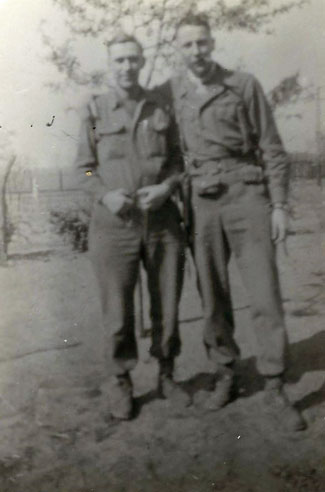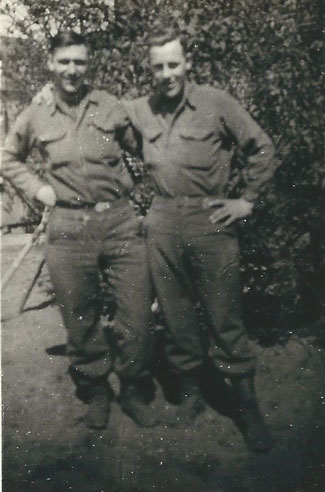 |
134th Infantry Regiment
"All Hell Can't Stop Us"
|
 |
Pfc. Harry A. Krantz
Combat Medic, 134th Infantry Regiment

Aid Man - Company C, 2nd Platoon
 |
 |
 |
Pfc Harry A Krantz - 1945
|
Pfc Harry A Krantz & Lt Joseph E Hein - 1945
|
Pfc Wesley Y Hasty - Pfc Harry A Krantz & Pfc
Robert R Richardson
|
 |
 |
 |
Pfc Harry A Krantz & S/Sgt Floyd M Sheffield -
1945
|
Lt Joseph E Hein - 1945
|
Pfc Harry A Krantz & Pfc Wesley Y Hasty - 1945
|
Harry A. Krantz was born in Chicago, Illinois on May 30, 1920. He was
drafted and inducted into the Army June 28, 1943 and entered active service two
weeks later on July 12, 1943 at Camp Grant, Illinois. He was 23 years old and
single, the eldest son of Anton and Mary Krantz. At the time of his induction he
was a baker at a commercial bakery in Chicago. After basic training, he departed
for the European Theater of Operations (ETO) on January 2 arriving in England
January 11, 1944.
His first assignment in the ETO was as a cook with Supreme Headquarters
Allied Expeditionary Force (SHAEF). At that time SHAEF was at Camp Griffiss,
Bushy Park, London, England. SHAEF moved from London to Versailles, France in
August 1944. Pfc. Krantz continued to serve as a cook with SHAEF until October
11 when he was transferred through a series of replacement depots to Tidworth
Barracks in south-east Wiltshire, England arriving there October 21, 1944. While
at Tidworth he received training as a Medical Aid Man. After completing this
training, he again traveled through a series of replacement depots before
arriving at the 38th Replacement Battalion at Morhange, France on December 11,
1944. Two days later he received his final assignment to the 35th Infantry
Division.
Pfc. Harry A. Krantz joined the Medical Detachment, 134th Infantry
Regiment, 35th Infantry Division on Wednesday, December 13, 1944. He was
assigned as an Aid Man (Combat Medic) to the 2nd Platoon of Company C. Although
officially part of the Medical Detachment, Aid Men during WWII travelled with
and were essentially a part of the infantry unit to which they were assigned.
Their mission was to accompany the infantrymen, provide medical assistance and
stabilize the wounded until they could be transported to an Aid Station. As
medical personnel they were not permitted to carry weapons.
Just days before his arrival, the 35th Infantry Division fought its way
into Germany inflicting and sustaining heavy casualties. The day prior to his
arrival, the Division crossed the Blies River and entered the town of
Habkirchen, Germany. The day of his arrival, during the early morning hours of
December 13, 1944, they launched a large-scale offensive and after six days of
fierce fighting a bridgehead into Germany was secured. On December 19, 1944,
after fighting for 162 consecutive days, the 35th Infantry Division was ordered
to hold and consolidate. Pfc. Krantz was awarded a Combat Medical Badge. The
35th Division moved to Metz, France on December 23, 1944 where they spent
Christmas before being sent to the Ardennes to fight in the Battle of the Bulge.
On Christmas night the order to move was received and within 24 hours of
leaving Metz they were in the thick of battle near Bastogne, Belgium. According
to their Unit History, the Battle of the Bulge cost the Regiment 1,449 battle
casualties including 140 killed, 1,011 wounded, and 298 missing. When most other
units of the 35th Infantry Division left the Bastogne area and moved back to
Metz, France January 18 - 19, 1944, the 134th Infantry Regiment remained in the
Ardennes and continued fighting there as Combat Team 134 attached to the 6th
Armored Division. Pfc. Krantz was wounded in action on Tuesday, January 23, 1945
near Troine, Luxembourg. He was treated at the 1st Battalion Aid Station at
Hachiville but remained on duty. He was awarded a Purple Heart for his wounds.
Two days later, on January 25, 1945, Company C launched an attack from a
wooded area over a snow-covered open field, toward the German held town of
Weiswampach, Luxembourg. The town was situated approximately a mile or two away
at a slightly elevated position. As the men of Company C started across the
field, the enemy opened fire with mortars, small arms, and machine guns pinning
them down, killing twelve and wounding twenty-one. Pfc. Harry A. Krantz was
awarded a Bronze Star Medal for heroic action during this battle. According to
his award citation "Because of the type of enemy fire utilized, it was difficult
for medical aid personnel to move about, but Private Krantz, an aid man, with
complete disregard for personal safety, moved among the personnel of Company C,
administering first aid and, in many instances, carrying wounded to the safety
of woods in the rear." On January 31, 1945, the 134th Infantry Regiment was
detached from the 6th Armored Division and began the move north to rejoin the
rest of the 35th Division in the vicinity of Gravenvoeren, Belgium about 10
miles south of Maastricht, Holland.
By early February 1945, Company C moved to the vicinity of Bocket, Germany,
about 40 miles south west of Dusseldorf. Plans were made for the 35th Division
to cross the Roer River on February 10, 1945, but the retreating enemy opened 2
large dams flooding the Roer River Valley and the surrounding countryside thus
delaying the river crossing. The night of February 25, 1945 the 1st Battalion,
134th Infantry Regiment, of which Company C was a part, stormed the town of
Hilfarth, Germany situated on the west bank of the Roer River and cleared the
town of the enemy the next morning. By the end of February, the Roer River was
crossed near Huckelhoven, Germany and the 35th Division swung north along the
eastern bank, rapidly advancing to the west bank of the Rhine River. Early March
found the Regiment in the vicinity of Venlo, Holland and on March 26, 1945, they
crossed the Rhine River near Rheinberg, Germany about 25 miles north west of
Essen.
During April 1945, the 134th Infantry Regiment continued its advance
eastward across Germany toward the Elbe River. The end of the month saw the
Regiment on occupation duty in the vicinity of Hannover where they were when the
war in Europe ended on V-E Day. Another move in mid-May brought them to the
Koblenz area of Germany, at the confluence of the Rhine and Moselle Rivers,
where they continued occupation duty. Pfc. Krantz began his journey home in
mid-July 1945, being redeployed with the rest of the Regiment to the tent city
of Camp Norfolk, about 40 miles southeast of Reims, France. Departing the Port
of LeHavre in mid-August for England, they spent a short time at Tidworth
Barracks before sailing for the U.S. from Southhampton, England on September 5,
1945 aboard the Queen Mary.
The Queen Mary dropped anchor in New York Harbor five
days later on Monday, September 10, 1945.
From there the troops traveled by rail to Camp Kilmer NJ.
The following day Pfc. Harry A. Krantz was assigned "for purpose of
recuperation" to Camp Grant, Illinois, the same post where he had entered active
service. He was relieved of
assignment and discharged from the Army on November 6, 1945.
A lifelong Chicagoan, after the war he continued to work as a baker until
his retirement. Harry A. Krantz
passed away December 13, 1985. He is
buried at Windridge Memorial Park and Nature Sanctuary in Cary, IL.
|

Bronze Star Medal Citation
|
|
Private First Class Harry A. Krantz, 36674236, Medical Department, United States Army, for heroic service in connection with military operations against an enemy of the United States at ****, Belgium on 25 January 1945. When Company C, 134th Infantry, launched an attack over an open field, the enemy employed grazing fire, pinning down Company C and forcing it into a fire fight. Because of the type of enemy fire utilized, it was difficult for medical aid personnel to move about, but Private Krantz, an aid man, with complete disregard for personal safety, moved among the personnel of Company C, administering first aid and, in many instances, carrying wounded to the safety of woods in the rear. Private Krantz' bravery, coolness, devotion to duty and disregard for personal safety, denote him an asset to his unit and a credit to the Medical Department of the Army. Entered military service from Illinois.
General Orders 16, Headquarters 35th Infantry Division, 9 March 1945
|
|

Purple Heart Medal
|
|
Wounded in action January 23, 1945
General Orders 11, Headquarters 35th Infantry Division, 12 February 1945
|

Pfc Harry A Krantz
Picture of Nazi Flag captured by 2nd Platoon Company C, signed by Pfc. Harry A. Krantz
Group Photo - Supreme
Headquarters Allied Expeditionary Force (SHAEF), Headquarters Company - 1944











